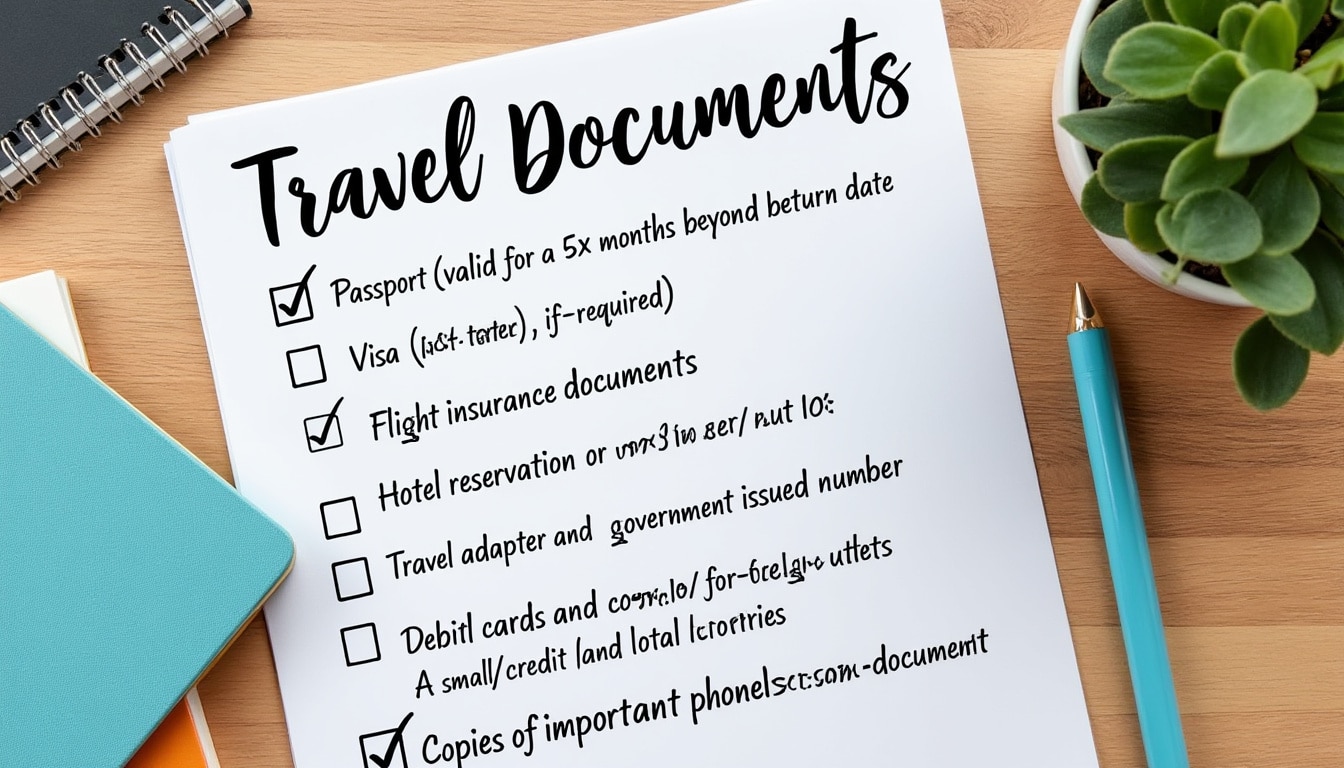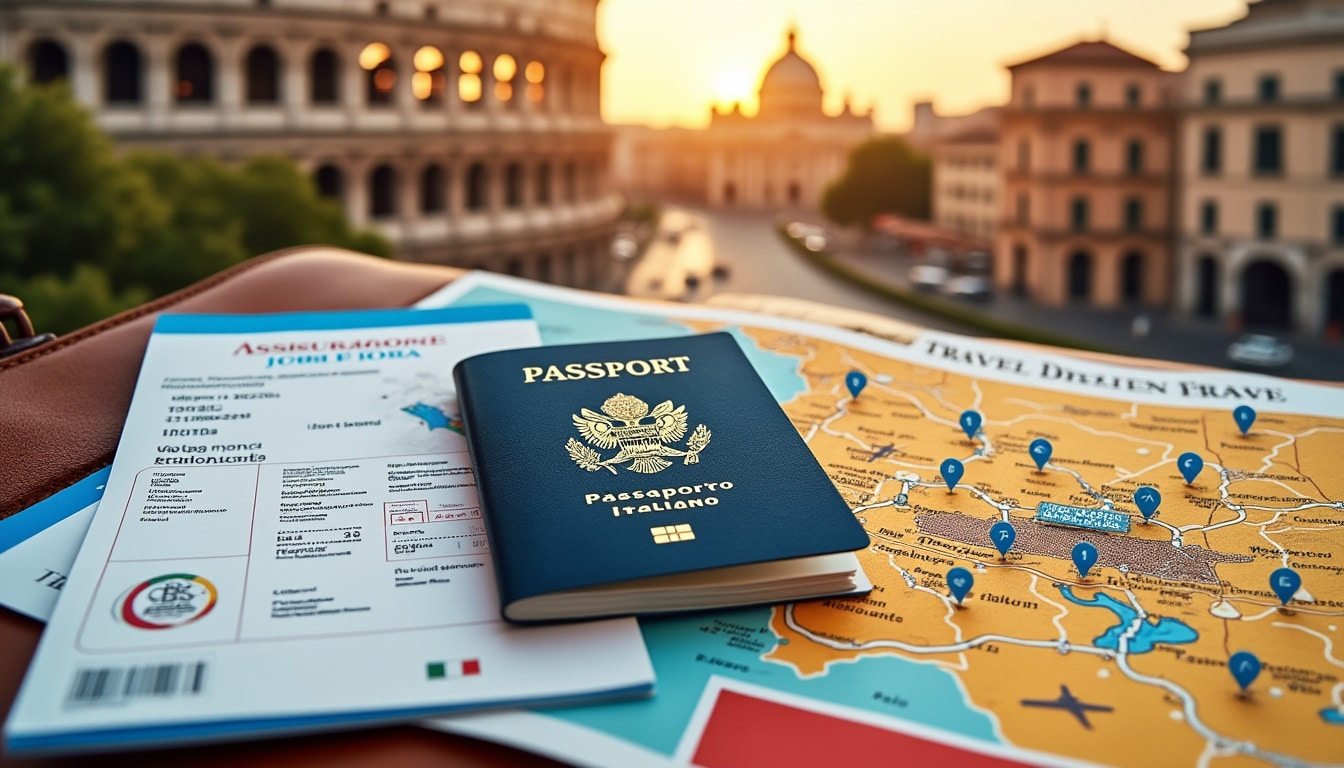Venturing to Rome, a city steeped in history and art, requires not just enthusiasm but some essential paperwork, too. Whether you’re sipping espresso with a view of the Colosseum or getting lost in the alleys of Trastevere, savvy travelers know the importance of having the right documents on hand. From visas to travel insurance, navigating these requirements ensures a smooth Roman holiday, free from the pitfalls of unexpected travel hiccups.
Visas and Passports: Navigating Rome’s Entry Requirements
Traveling to Rome requires a well-rounded understanding of the entry regulations specific to your nationality. The requirements for documents like visas and passports can vary significantly depending on your country of origin.
For EU citizens, traversing Italy’s borders is as simple as flashing a national ID card or a passport, thanks to the benefits of the Schengen Agreement. This convenience allows free movement without the need for visas. Imagine a German art student hopping on a budget airline to explore Rome’s treasures—you don’t need a visa, just your ID.
For non-EU travelers, the scenario changes. Visitors from countries like the United States or United Kingdom can enter Italy without a visa for tourism purposes for up to 90 days. However, it’s crucial to ensure your passport remains valid for at least 6 months beyond your planned stay. This is a critical point missed by some travelers, resulting in stressful last-minute renewals.
Certain non-European countries benefit from bilateral agreements, permitting entry without a visa for brief visits. For instance, Australians and New Zealanders enjoy similar privileges but should be mindful of passport validity rules and the necessity of a return ticket. Whether you’re there to explore Vatican City or indulge in the culinary delights of Testaccio, keeping these requirements in mind prevents potential headaches at customs.
For those who hail from destinations that require a visa, the process involves applying through the Italian Embassy or Consulate in your respective countries. Facilitated by services such as VFS Global, these visas are typically granted within a 90-day window. Therefore, adequately planning your Italian escapade is essential, ensuring all documentation is in order well ahead of your departure.
Should you find yourself questioning the documentation specifics, online resources like Rome Circuit offer handy guides and tips, making your travel preparations much more seamless. For real-time updates, checking the official Italian Ministry of Foreign Affairs website can clarify visa requirements, even as policies evolve in 2025.
Visa Types and Their Relevance
Understanding the category of visas is crucial. Short-term visas such as the Schengen Visa cater to tourists and are valid for stays up to 90 days. When applying, present proof of sufficient funds, travel insurance, and a confirmed itinerary. Long-term visas, however, cater to individuals intending to work or study and require thorough documentation. Specialist consultancies like TravelVisaPro can streamline these applications.
In deciding the right visa, consider the purpose of your visit. Are you a digital nomad testing Rome’s vibrant co-working scene, a student at Sapienza University, or a gastronome indulging in pasta at every turn? Each scenario may dictate different visa requirements, affecting your preparations.
- 👜 For tourists: A simple passport may suffice.
- 📚 For students: Student visas require proof of enrollment and accommodation.
- 💼 For professionals: Work visas demand sponsorship from an Italian employer.
Embarking on a Roman holiday is an invigorating adventure, yet being improperly informed about your required documentation could quash the spirit of spontaneity. Remember that having a valid passport, applicable visa, and an understanding of entry policies is invaluable to your travel plan. Whether lounging in the Baths of Caracalla or savoring gelato by the Tiber, readiness allows you to truly appreciate Rome’s splendors.
Declarations of Presence and the Schengen Stamp
Once you’ve successfully entered Italy, your stay becomes subject to certain documentation requirements that travelers often overlook. Travelling from outside the Schengen Area entails that you receive a Schengen stamp upon entry—this crucial step documents your official presence without needing additional paperwork. Imagine introspecting in the Sistine Chapel with the confidence that your paperwork is in order.
However, entering Italy from within the Schengen Area, you will need to fill out a Declaration of Presence and submit it to the Police Headquarters of the province you’re staying in. This declaration ensures that your presence is recorded officially. If your lodging is handled at a hotel or registered accommodation, the declaration is submitted on your behalf, though carrying a copy is always advisable.
Understanding the nuances of this process can save you a considerable amount of hassle. Whether you’re planning to meander through Villa Borghese gardens or take a culinary class to master traditional Roman cuisine, it is important to recognize these legalities to avoid any interruption in your Italian experience.

Here’s a sample list of what you should ensure:
- 📑 Passport stamp from the Schengen border
- 📝 A copy of the Declaration of Presence, when applicable
- 🏨 Proof of lodging (e.g., hotel confirmation)
Accommodations and Reporting Obligations
If your accommodations are nestled within Rome’s historic center or buzzing Trastevere, ensure that your host or hotel management submits your presence declaration on your behalf. This relieves you from unwarranted bureaucracy, allowing more time to enjoy the city. However, confirming this act with the accommodation manager is always a wise precaution. Foresight into these mandates ensures you enjoy your Roman holiday without administrative worries over your shoulder.
For comprehensive insight into the rules governing Rome’s entry requirements in 2025 and beyond, you can consult Rome Circuit’s Legal Guide. With these resources, ensure your documents are immaculate, fostering an undisturbed Roman journey.
The Role of Travel Insurance in Your Roman Adventure
Travel insurance, while often an afterthought, plays a vital role in ensuring your peace of mind during your visit to Italy’s capital. Imagine navigating Rome’s cobbled streets, knowing you’re shielded from potential mishaps.
Whether mitigating medical emergencies or safeguarding against unexpected flight cancellations, travel insurance is a crucial component of travel preparations. Services such as Expedia and Kayak frequently include travel insurance options when booking flights and accommodations, simplifying the acquisition process. In 2025, the unpredictability of travel necessitates this safety net more than ever before.
Common Inclusions in Travel Insurance:
- 🩺 Emergency medical expenses
- ✈️ Trip cancellations and delays
- 🛅 Loss or theft of luggage
- 🚑 Medical evacuations
Navigating Claims and Coverage
Understanding the claims process can facilitate quick resolutions during your journey. Ensure you grasp what your insurer requires, such as detailed documentation, receipts, and police reports if needed. Having all protocols mapped out ensures that should an incident arise while you’re gazing at Roman art in a museum or attending a culinary festival, you can handle it efficiently, minimizing disruption to your adventures.
For example, during a crowded outing to the Trevi Fountain, should your wallet be misplaced due to petty theft, immediate reporting can expedite an insurance claim process. Online platforms like Rome Circuit’s Safety Tips provide insights into Rome’s common tourist challenges and how to mitigate them.
Comprehensive travel insurance not only covers eventualities but allows a deeper indulgence into Rome’s offerings, from the Vatican’s sacred spaces to bustling culinary bazaars, with absolute peace of mind.
The Ultimate Travel Document Checklist for Rome
As you prepare for an enchanting Roman getaway, organizing the necessary travel documents is as vital as planning your itinerary. A well-prepared travel document checklist ensures no crucial paper is left behind.
| 📃 Document | ⚠️ Importance | ✔️ Checked |
|---|---|---|
| Valid passport | Mandatory for entry | ✅ |
| Visa (if required) | Essential for non-EU citizens | ✅ |
| Travel insurance | Highly recommended | ✅ |
| Proof of Accommodation | May be required at customs | ✅ |
| Return flight ticket | Proof of intended departure | ✅ |
Cross-referencing your possession of these documents before embarking on your journey ensures a stress-free exploration of Rome’s wonders. Whether planning to marvel at Michelangelo’s works in the Vatican Museum or enjoy the Socratic dialogues amid ancient ruins, these preparations guarantee administrative regulations won’t impede your cultural indulgence.
Additional Considerations for Your Roman Holiday
Beyond passports and visas, a few final travel logistics can complement your trip planning. Digital backups of all essential documents ensure an added layer of security, particularly if originals are misplaced. Platforms like Tripadvisor provide user-generated advice, sharing insights and experiences from other globetrotters.
Embrace Rome’s unpredictable weather by monitoring Rome Circuit’s climate guide. The moderate Mediterranean climate typically beckons travelers to anticipate weather variations, ensuring your itinerary remains flexible and enjoyable regardless of rain or shine.
Lastly, understanding currency options simplifies transactions during your trip. In 2025, digital wallets and contactless payments have become mainstream, yet carrying some euros in cash remains advisable for smaller vendors and markets.
- 💳 Utilize contactless payments for efficiency.
- 💶 Maintain cash reserves for local markets.
- 📲 Keep a mobile travel app for digital backups.
Armed with this knowledge and preparation, stepping into Rome becomes more than just a journey; it’s an experience enriched by readiness. Soak in the city’s historic ethos, savor local gastronomy, and capture timeless moments, all supported by meticulous preparation and planning.
FAQ: Travel Documents for Rome
- Q: Do US citizens need a visa for Italy?
- A: No, they do not need a visa for stays up to 90 days for tourism purposes.
- Q: What is the Schengen stamp, and is it necessary?
- A: Yes, it is stamped on your passport upon entry to Schengen countries to record your presence.
- Q: Can I use my ID card to enter Italy if I’m from the EU?
- A: Yes, an ID card is sufficient for entry for EU citizens.

